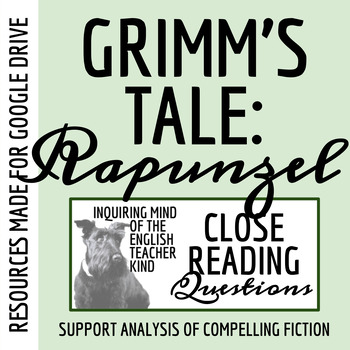"Rapunzel" by the Brothers Grimm Close Reading Analysis Worksheet (Google Drive)
- Google Drive™ folder

What educators are saying
Also included in
- Support the development of close reading skills for high school with this bundle of rigorous comprehension and analysis worksheets covering 25 fairy tales written by the Brothers Grimm. With these resources, students will demonstrate command of general plot, build their vocabulary, write with clariPrice $38.00Original Price $54.00Save $16.00
- Evaluate general reading comprehension, facilitate vocabulary development, and sharpen critical thinking skills with this bundle of materials for teaching the classic Grimm's fairy tale "Rapunzel" (Lexile Measure estimate of 1010-1200). A plot-based quiz, a close reading worksheet, a vocabulary applPrice $6.30Original Price $7.00Save $0.70
Description
Fairy tales are not just for elementary students; even high school readers can use (and enjoy) fairy tales as a tool for practicing close reading analysis skills. This worksheet composed of rigorous questions covers "Rapunzel" by the Brothers Grimm. With an estimated Lexile Measure range of 1010-1200, the short story is suitable for both middle and high school students. The briefness of the narrative also makes it an appropriate time-filler for awkward gaps in teaching schedules. An answer key and copy of the public domain narrative are provided. Materials are made for Google Drive, offering self-grading functionality for multiple choice questions. (Alternatively, a printable option is available.)
By completing this exercise, students will:
- Articulate what is stated in the text explicitly and implicitly
- Explore character motivations
- Analyze how complex characters think, behave, and interact with others
- Examine tone
- Analyze the authors' craft, paying special attention to diction in order to make logical inferences
- Apply knowledge of various literary devices including simile, situational irony, and dramatic irony
- Analyze nuances in words with similar meanings
- Choose the most synonymous word to replace a word used in the text
- Write with clarity, accuracy, and precision
This resource may facilitate small-group discussions in which students decode language and pose/respond to questions relating to plot, broad topics, and character development. Using this resource for structured guidance, students will improve their ability to present information, conclusions, and supporting textual evidence clearly and convincingly.
A variety of resources are available for teaching fantasy fiction and fairy tales:







